Leidos Bundle
How did Leidos evolve into a tech giant?
Embark on a journey through time to uncover the remarkable Leidos SWOT Analysis and its transformation into a global powerhouse. From its humble beginnings addressing critical national issues to its current status as a leading technology solutions provider, Leidos's story is one of continuous innovation and strategic adaptation. Discover the key milestones that shaped this industry leader and the pivotal moments that defined its path.
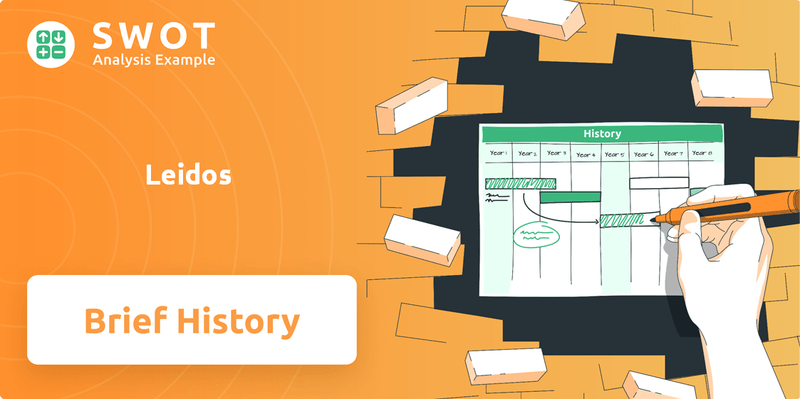
Founded in 1969 as SAIC, the Leidos company has a fascinating Leidos history. This Leidos journey showcases its evolution through strategic acquisitions and a commitment to providing cutting-edge Leidos services. Explore the Leidos leadership and the core business areas that have driven its success.
What is the Leidos Founding Story?
The story of Leidos, formerly known as Science Applications Incorporated (SAI), began in February 1969. Dr. J. Robert Beyster, a physicist from Los Alamos National Laboratory, established SAI with a vision to apply scientific and technical expertise to solve complex problems, particularly for government agencies. This marked the beginning of what would become a significant player in the defense, intelligence, and health markets.
The initial focus of SAI was providing specialized scientific consulting and research services. The company quickly became known for its work in nuclear safety analyses and environmental studies. The name 'Science Applications Incorporated' was carefully chosen to reflect its core mission of applying scientific principles to real-world challenges. The company's early success was fueled by the Cold War era's demand for specialized expertise in national security and defense.
Early funding for SAI involved Dr. Beyster's personal investment of $10,000 and a small loan. This bootstrapping approach allowed the company to establish itself and begin securing contracts. Dr. Beyster's background in nuclear physics was crucial, providing the technical foundation that helped attract early clients and projects. The company's growth was also influenced by the increasing need for independent scientific analysis and technical support for critical national security and environmental programs.
Explore the origins of Leidos, from its inception to its early business model.
- Founded in February 1969 as Science Applications Incorporated (SAI) by Dr. J. Robert Beyster.
- Focused on providing scientific consulting and research services to government agencies.
- Early work included nuclear safety analyses and environmental studies.
- Initial funding included Dr. Beyster's personal investment and a small loan.
Leidos SWOT Analysis
- Complete SWOT Breakdown
- Fully Customizable
- Editable in Excel & Word
- Professional Formatting
- Investor-Ready Format
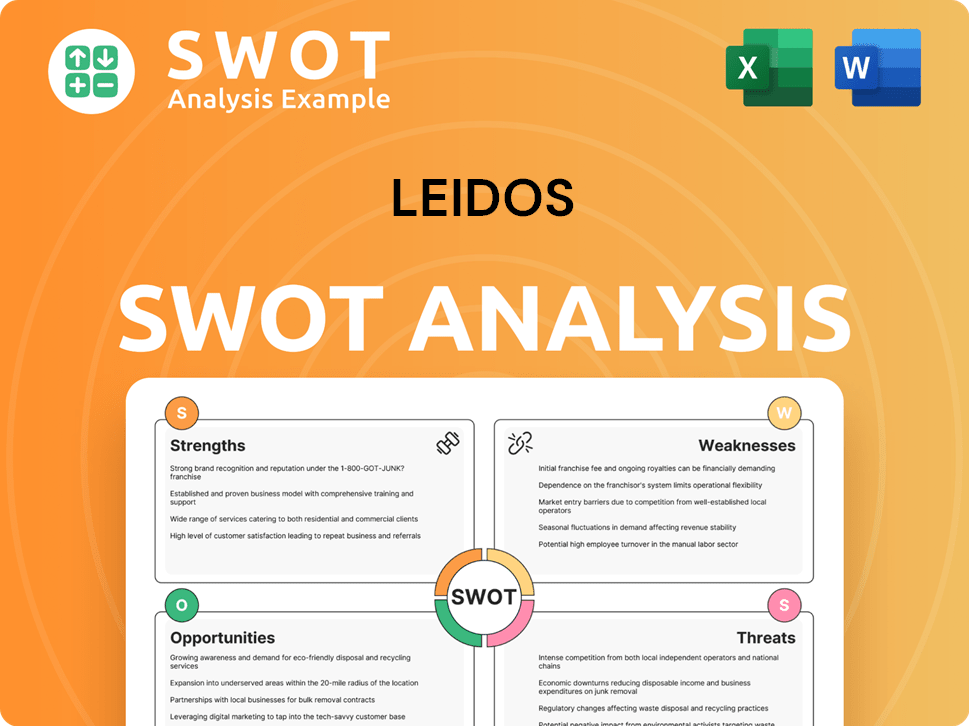
What Drove the Early Growth of Leidos?
The early years of Leidos, then known as SAIC, were marked by substantial growth fueled by its proficiency in scientific and technical services. The company's initial offerings included advanced modeling, simulation, and specialized software development, primarily for government clients. This period saw the expansion of its team and the establishment of additional office locations to meet growing project demands.
Early Leidos services included advanced modeling and simulation, systems engineering, and specialized software development. These services were primarily targeted at government clients, establishing a foundation for future growth. The focus on technical expertise helped the company secure significant government contracts early on.
The U.S. Department of Defense and other federal agencies were among Leidos's initial key clients. Securing contracts with these entities provided a stable revenue stream and opportunities for expansion. Early client relationships were crucial in building Leidos's reputation and expertise in the government sector.
Leidos expanded into new markets such as energy, environmental management, and healthcare IT. The initial public offering (IPO) in 1986 was a significant milestone, providing capital for further expansion. This financial backing facilitated strategic acquisitions and broader market penetration.
Leidos made strategic acquisitions to enhance its capabilities and market reach. The acquisition of Network Solutions in 1995, though later divested, showed early interest in internet infrastructure. Leadership transitions, including Dr. Beyster's retirement, guided the company through different growth phases.
Leidos PESTLE Analysis
- Covers All 6 PESTLE Categories
- No Research Needed – Save Hours of Work
- Built by Experts, Trusted by Consultants
- Instant Download, Ready to Use
- 100% Editable, Fully Customizable
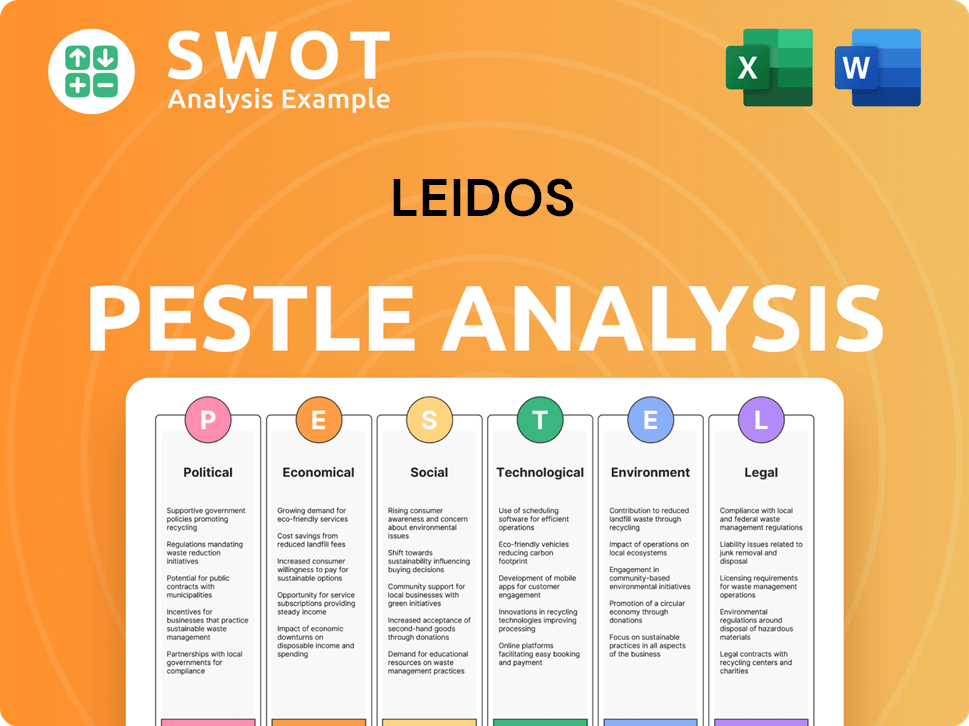
What are the key Milestones in Leidos history?
The Leidos company has a rich history marked by significant milestones, strategic pivots, and a commitment to innovation in the fields of national security, health, and engineering. From its early days to its current position as a leading government contractor, Leidos has consistently adapted to market changes and technological advancements.
| Year | Milestone |
|---|---|
| 1969 | Founded as the Planning Research Corporation (PRC), marking the beginning of its journey in providing technical services to government agencies. |
| 1991 | PRC is acquired by the Carlyle Group, a significant move that set the stage for future strategic developments. |
| 2013 | SAIC splits into two independent, publicly traded companies: SAIC and Leidos, with Leidos focusing on national security, health, and engineering. |
| 2016 | Leidos acquires Lockheed Martin's Information Systems & Global Solutions (IS&GS) business, significantly expanding its capabilities and market share. |
| 2020 | Leidos was awarded a contract by the U.S. Navy for the design and construction of a new unmanned surface vessel. |
| 2024 | Leidos continues to secure major government contracts, demonstrating its ongoing relevance and capability in critical areas such as cybersecurity and healthcare IT. |
Leidos has consistently been at the forefront of technological innovation, particularly in areas crucial to national security and public health. Their pioneering work spans cybersecurity, advanced analytics, and integrated systems, enabling complex defense and intelligence operations.
Leidos develops and implements advanced cybersecurity solutions to protect critical infrastructure and sensitive data for government and commercial clients. These solutions include threat detection, incident response, and security assessments.
The company is actively involved in applying artificial intelligence and machine learning to enhance decision-making and operational efficiency across various sectors. This includes AI-driven analytics for defense and healthcare.
Leidos provides advanced health IT solutions, including electronic health records systems, data analytics, and interoperability solutions, to improve healthcare delivery. They support federal healthcare agencies and commercial healthcare providers.
They develop and deploy secure communication systems, ensuring reliable and protected information exchange for government and military operations. This includes satellite communications and secure networks.
Leidos leverages data analytics to provide actionable insights for clients in areas such as national security, healthcare, and transportation. They use advanced analytics to improve decision-making and operational effectiveness.
Leidos specializes in integrating complex systems for defense, intelligence, and civil markets, ensuring seamless operation and enhanced capabilities. This includes systems integration for air traffic management and border security.
Despite its successes, Leidos has faced various challenges, including market fluctuations and the complexities of large-scale government contracts. The company has also had to navigate competitive pressures and internal restructuring efforts to maintain its position in the industry.
Leidos has experienced challenges related to market downturns, which can impact government spending and contract opportunities. Economic fluctuations can affect the company's financial performance and strategic planning.
The company operates in a highly competitive environment, facing competition from other major government contractors and technology firms. Maintaining a competitive edge requires continuous innovation and strategic acquisitions.
Managing large-scale government contracts involves navigating complex regulatory environments and budget constraints. Compliance and performance requirements can be demanding, requiring significant resources and expertise.
The 2013 split of SAIC into two separate entities, SAIC and Leidos, was a significant restructuring that required strategic realignment. This involved adapting to new market dynamics and organizational changes.
Integrating acquired businesses, such as Lockheed Martin's IS&GS, presents challenges in terms of merging cultures, systems, and operations. Successful integration is crucial for realizing the full value of acquisitions.
Government budget constraints can impact the availability of funding for projects and contracts. Leidos must manage projects efficiently and adapt to changing budget priorities.
Leidos Business Model Canvas
- Complete 9-Block Business Model Canvas
- Effortlessly Communicate Your Business Strategy
- Investor-Ready BMC Format
- 100% Editable and Customizable
- Clear and Structured Layout
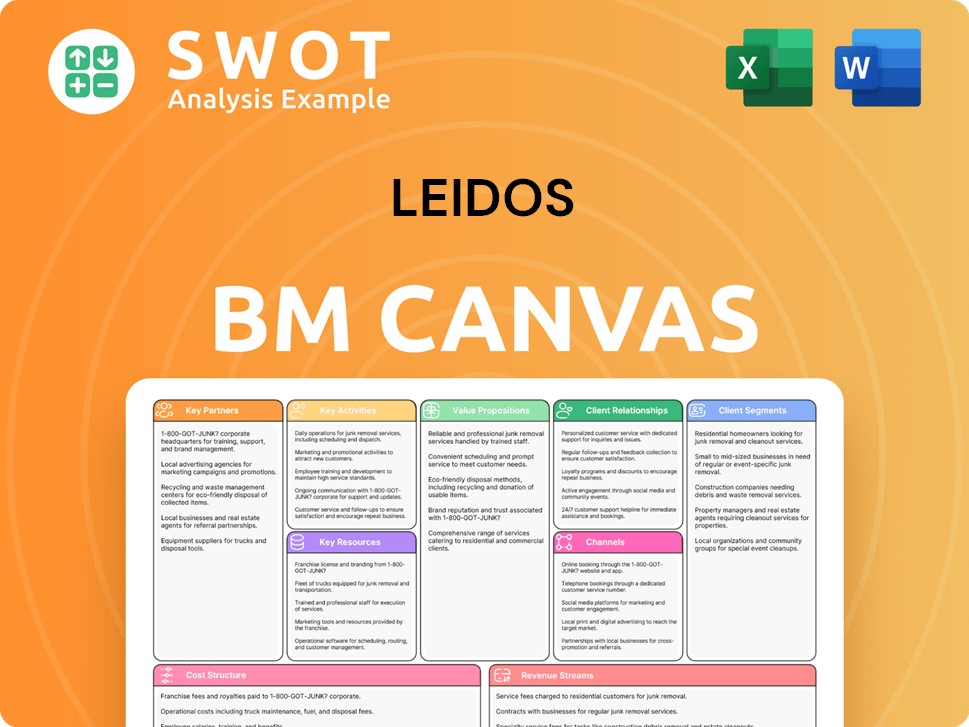
What is the Timeline of Key Events for Leidos?
The Leidos company has a rich history, marked by significant milestones that have shaped its evolution in the defense, intelligence, and health markets. From its founding as Science Applications Incorporated (SAI) in 1969 to its current status as a leading government contractor, Leidos has consistently adapted and expanded its capabilities through strategic acquisitions and a focus on innovation. The company’s journey reflects a commitment to solving critical challenges for its clients, particularly in the areas of digital modernization, cybersecurity, and advanced analytics.
| Year | Key Event |
|---|---|
| 1969 | Founded as Science Applications Incorporated (SAI) by Dr. J. Robert Beyster. |
| 1986 | Initial Public Offering (IPO) as SAIC. |
| 1995 | Acquisition of Network Solutions (later divested). |
| 2013 | SAIC splits into two companies: SAIC and Leidos. |
| 2016 | Leidos acquires Lockheed Martin's IS&GS business for approximately $4.6 billion, expanding its defense and intelligence sector presence. |
| 2019 | Leidos acquires Dynetics for $1.65 billion, bolstering its capabilities in hypersonics, space, and directed energy. |
| 2020 | Awarded significant contracts, including a $2.9 billion contract for IT services for the U.S. Navy and Marine Corps. |
| 2021 | Secures a $3.5 billion contract to modernize the IT infrastructure of the National Security Agency (NSA). |
| 2023 | Reports full-year revenues of $15.7 billion, demonstrating continued growth. |
| 2024 | Continues to secure major government contracts, including a potential $700 million contract with the Department of Homeland Security. |
Leidos anticipates continued growth driven by demand in digital modernization, cybersecurity, and advanced analytics for government clients. The company is well-positioned to capitalize on increasing government spending in these areas. Strategic acquisitions and internal investments support the company's expansion plans.
Leidos is focused on expanding its digital modernization and artificial intelligence capabilities, particularly in the defense and intelligence sectors. Market expansion plans include pursuing international opportunities and deepening its presence in the civil and health markets. Innovation roadmaps center on developing cutting-edge solutions in areas like hypersonics and autonomous systems.
Analysts predict continued stable growth for Leidos, given its strong backlog of government contracts and its strategic alignment with national security priorities. The company's revenue in 2023 reached $15.7 billion, demonstrating its robust financial performance. Leidos is likely to maintain its strong financial position in the coming years.
Leidos's leadership emphasizes a commitment to delivering innovative solutions that address the nation's most critical challenges. This vision directly ties back to Dr. Beyster's founding principle of applying science to solve problems of national significance. The company's focus remains on providing cutting-edge solutions.
Leidos Porter's Five Forces Analysis
- Covers All 5 Competitive Forces in Detail
- Structured for Consultants, Students, and Founders
- 100% Editable in Microsoft Word & Excel
- Instant Digital Download – Use Immediately
- Compatible with Mac & PC – Fully Unlocked
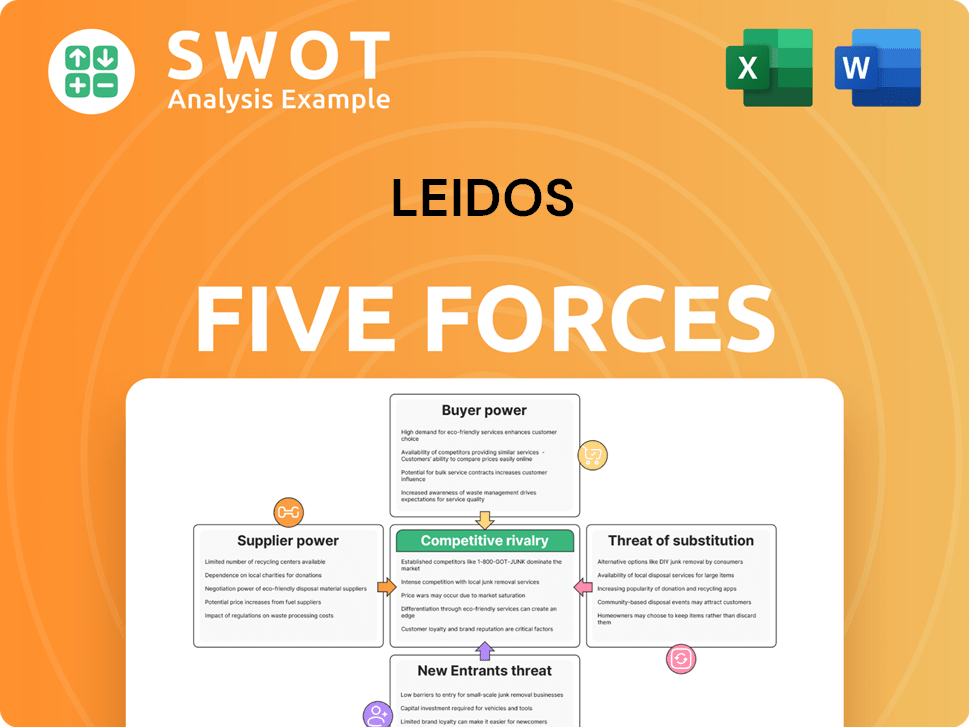
Related Blogs
- What is Competitive Landscape of Leidos Company?
- What is Growth Strategy and Future Prospects of Leidos Company?
- How Does Leidos Company Work?
- What is Sales and Marketing Strategy of Leidos Company?
- What is Brief History of Leidos Company?
- Who Owns Leidos Company?
- What is Customer Demographics and Target Market of Leidos Company?
Disclaimer
All information, articles, and product details provided on this website are for general informational and educational purposes only. We do not claim any ownership over, nor do we intend to infringe upon, any trademarks, copyrights, logos, brand names, or other intellectual property mentioned or depicted on this site. Such intellectual property remains the property of its respective owners, and any references here are made solely for identification or informational purposes, without implying any affiliation, endorsement, or partnership.
We make no representations or warranties, express or implied, regarding the accuracy, completeness, or suitability of any content or products presented. Nothing on this website should be construed as legal, tax, investment, financial, medical, or other professional advice. In addition, no part of this site—including articles or product references—constitutes a solicitation, recommendation, endorsement, advertisement, or offer to buy or sell any securities, franchises, or other financial instruments, particularly in jurisdictions where such activity would be unlawful.
All content is of a general nature and may not address the specific circumstances of any individual or entity. It is not a substitute for professional advice or services. Any actions you take based on the information provided here are strictly at your own risk. You accept full responsibility for any decisions or outcomes arising from your use of this website and agree to release us from any liability in connection with your use of, or reliance upon, the content or products found herein.